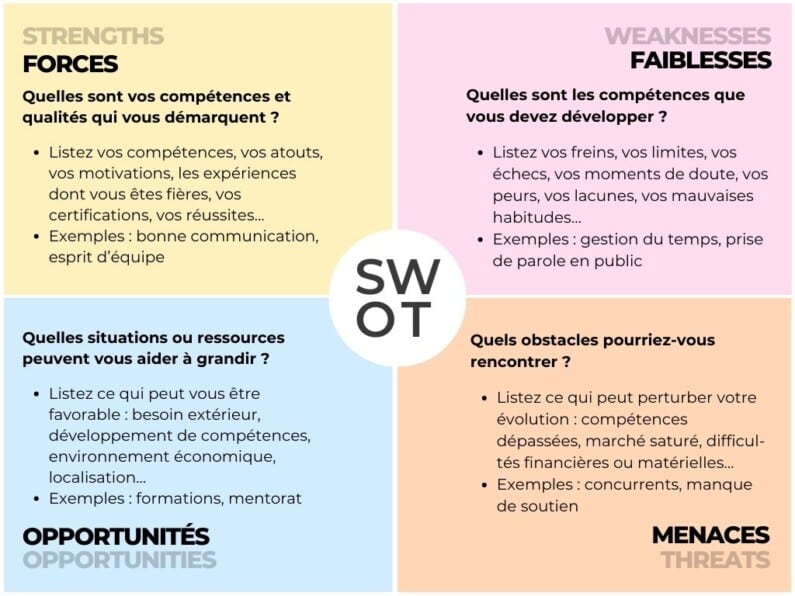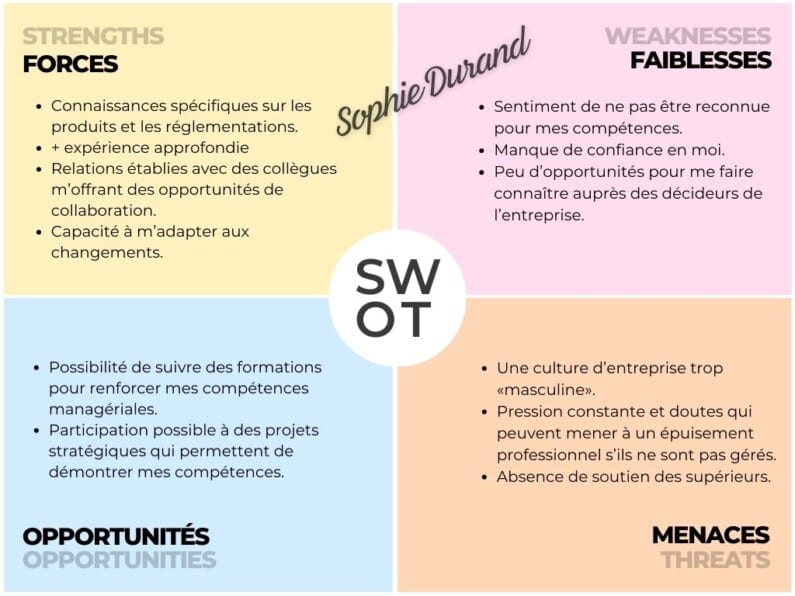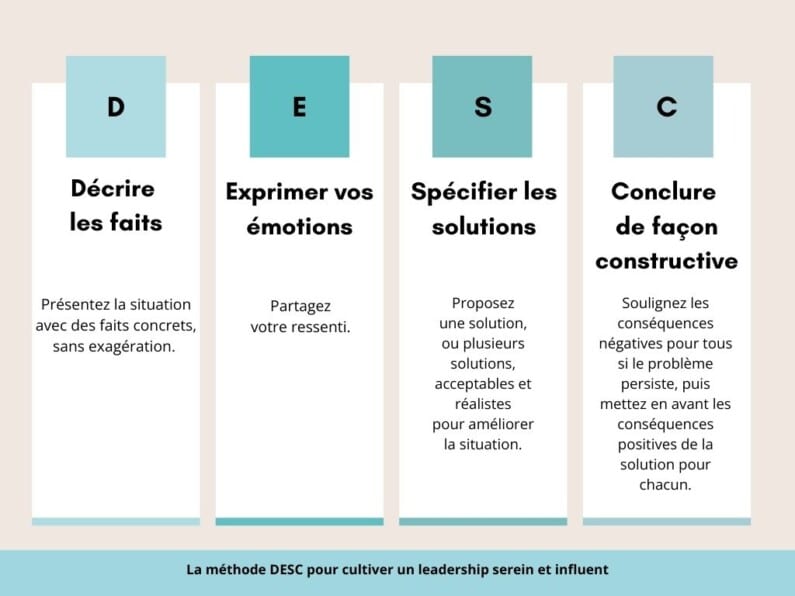From stereotype to reality: what is the true face of the leadership of women? Insights from Pascale Abekhzer, expert in leadership and communication management.

The specificity of female leadership
Between stereotypes and preconceived ideas
Women leaders face gender stereotypes which influence the perception of their managerial skills, both by their peers and by their subordinates.
These stereotypes manifest themselves :
- in the way they are assessed and treated
- and even in the way they assess each other
And this can significantly affect their careers.
On the one hand, society often associates leadership with masculine traits such as authority and competitiveness. However, women who adopt these characteristics are perceived as "masculine". too hard ". When those who show feminine qualities, such as theempathyare deemed " not ambitious enough ". This double standard forces women to adjust their leadership style in order to be recognised. It even keeps them under constant pressure to avoid negative judgements.
In fact, they develop a balanced leadership style, combining benevolence and firmness, adapted to a variety of managerial situations.
Stereotypes also influence performance expectations of women leaders. For example, they may be perceived as less competent in situations of stress or crisis. Or " too emotional "This is yet another biased view of their skills. Once again, this is a biased view of their skills.
However, this sensitivity can result in a better emotional intelligence and a more human approach to team management.
What's more, the myth that professional success implies a sacrifice of family life is based on outdated societal expectations.
Indeed, many women managers have shown that it is possible to reconcile a demanding career with a fulfilling family life, thanks to effective time management, rigorous organisation and, sometimes, outside support.
These distorted perceptions affect the self-esteem of women leaders. The consequences are twofold:
- they may internalise stereotypes and develop imposter syndrome, because they doubt their skills despite good results;
- This leads them to avoid senior positions and to undervalue themselves, which slows down their career development and can be perceived as a "barrier to entry". lack of ambition.
Contrary to popular belief, women are just as ambitious as men.
The example of Sophie, a manager in a pharmaceutical company
Preconceived ideas have a direct impact on women's careers, as Sophie's experience shows.
Despite her skills, she remains blocked in intermediate positionsWe are also seeing male colleagues, sometimes with less experience, taking on management roles. The biased assessments fuel its impostor syndrome, making her doubt her own worth.
During a leadership training course, Sophie became aware of her own strengths and of the weight of the obstacles she faced. bias that were holding back her career. Reading about women who have overcome these obstacles inspires her. To overcome her imposter syndrome, she kept a diary of her successes and reminded herself of her past successes. She then decided to apply for a managerial post, buoyed by a new-found self-confidence. After a demanding interview, she finally got the job, proving that her determination and skills can pave the way for other women.
This experience is part of a more general trend:

Two women managers who break stereotypes and have succeeded in sectors dominated by men

Sophie Adenot
European Space Agency astronaut (2022)
Sophie Adenot is an inspirational figure of female success in fields often dominated by men.
An engineer, helicopter pilot and astronaut, she is France's first female helicopter test pilot and was selected by the European Space Agency in 2022. Her first mission aboard the International Space Station is scheduled for 2026.
Her path, marked by discipline and perseverance, breaks down gender barriers and inspires women to pursue scientific and technical careers. Thanks to her commitment, she is opening up new horizons for humanity and encouraging female representation in these sectors.

Catherine MacGregor
Chief Executive Officer of Engie (2021)
Catherine MacGregor is an emblematic figure of female success in the energy sector, which is often perceived as male-dominated.
Appointed CEO of Engie in 2021, she stands out for her visionary leadership and expertise. A graduate of the École des Mines de Paris, she started out in technical roles before rising through the ranks at Schlumberger and GDF Suez. Under her leadership, Engie is moving towards a sustainable future, focused on renewable energies and technological innovation.
Her story inspires many women to take up careers in engineering and management, showing that female leadership is crucial to tackling global challenges and building an equitable future.
Women in leadership: what impact on business performance?
In an ever-changing business world, female leadership is emerging as a key success factor for companies. Recent studies reveal a significant link between gender diversity in management bodies and the overall performance of organisations. These include :
McKinsey points out that companies that include more women in their management teams achieve superior financial performance, demonstrating that inclusion is not just a moral imperative, but also a strategic asset.
KPMG (2019) highlights the importance of a change in the regulatory framework to encourage the feminisation of management bodies, stressing that proactive measures are needed to catalyse this change.
These analyses bear witness to thethe positive impact of female leadership on business performanceThis was the starting point for an in-depth reflection on the importance of gender equality in the business world.
How to discover your own leadership style
Identify your strengths and weaknesses
Understanding your strengths and weaknesses is essential for effective personal and professional development. Not only does it enable you to capitalise on your strengths, it also helps you identify areas for improvement. Here's 2 simple self-reflection and self-assessment exercises:
Journaling
Journaling involves writing regularly about your thoughts, emotions and experiences, providing a space for personal reflection. This practice allows you to take a step back from your actions, identify successes and failures and better understand your motivations. In just a few minutes a day, you can clarify your strengths, such as resilience and the creativityand your weaknesses, such as procrastination and lack of self-confidence.
Personal SWOT
Personal SWOT is a self-diagnosis technique that enables you to take stock of yourself and your professional situation. By analysing your strengths, weaknesses, opportunities and threats, you gain a better understanding of yourself, identify your talents and boost your self-confidence. This helps you to overcome your obstacles and take action.
How do you create your personal SWOT?

The SWOT example of Sophie, a manager in a pharmaceutical company

What practical strategies can you use to exercise leadership on a daily basis?
Developing your assertiveness
L'assertiveness is the ability to express oneself and defend one's rights while respecting those of others.
Here is a clear, structured table to illustrate assertiveness and opposing behaviours:
| Behaviour | Description | Mode of domination |
|---|---|---|
| Assertiveness | Express your needs and opinions with respect, without crushing or manipulating others | None: balance and mutual respect |
| Assault | Impose your ideas by force, intimidation or threat | Dominate by force |
| Submission | Avoiding conflict, abandoning your needs or allowing yourself to be dominated | Being dominated by others |
| Handling | Influencing others indirectly or deceptively | Dominating through cunning |
Assertiveness is the ideal behaviour, avoiding aggression, submission and manipulation, while adopting a balanced life position.
[Training]
Assertiveness is a skill that can be learned. After a self-diagnosis, it's time for practice: role-plays and games. role to practise handling criticism and defusing conflict situations. Find out more about the training programme: Assertiveness and assertiveness.
They're talking about :
"Very interesting content that helped me see a little more clearly about myself and my management method."
"The friendly atmosphere created by the trainer encouraged genuine and constructive exchanges between the participants.
[Also read]

"Assertiveness is now one of the most widely used terms in the professional world. Why is this? What does it mean in practice? Are we naturally assertive? What impact does it have? How can you work on your assertiveness? These are just some of the questions that need clarifying... "
"Dare to move forward and progress! To develop your assertiveness, you have to get out of your comfort zone and gradually take the 'risk' of evolving. In other words, you have to challenge yourself.
To develop this skill, 3 techniques to help you assert your leadership without becoming aggressive.
1/ The quilt technique for assertive leadership
Developed by Manuel J. Smith, it aims to communicate and assert yourself assertively while respecting the other person. It consists of 3 key responses:

These three answers will help you avoid pointless debates, get you out of uncomfortable situations or close a question in a neutral way.
2/ Knowing how to say no to strengthen your leadership
Knowing how to say no in a respectful way allows you to take a stand and set clear limits without brutality, because it opens the door to an alternative solution (one that suits you).
| NO... | BECAUSE... | BUT... |
|---|---|---|
| You say NO to the request (not to the person) with a neutral, rational and open tone. | BECAUSE indicates that you are not against the other person. You give them an explanation. | BUT allows you to bounce back from a proposal, rather than simply refusing it. |
3/ The DESC method for cultivating calm and influential leadership
Use the DESC method to respond to your interlocutor or get a difficult message across in a non-violent way, while maintaining positive relationships.

Boost your self-confidence
For example, use the positive visualisation. This mental preparation helps you to strengthen and improve your performance. By imagining yourself in a successful situation, you prepare your mind to tackle challenges with confidence, reducing stress and boosting your self-confidence.
How do you go about it?
First, find a quiet moment and visualise yourself in a successful leadership scenario. Then imagine every detail and feel the positive emotions.

Finally, incorporate positive visualisation into your routines to develop a success mentality.
A personalised action plan for successful leadership
To succeed as a leader, take the time to structure your actions.
First, clearly define your leadership objectives
Identify your short-, medium- and long-term ambitions. Develop strategies to achieve these goals while measuring your progress. Break down each objective into concrete actions. Set deadlines. Identify the resources you need. Implement these actions. Monitor your progress, then analyse and adjust your approach according to the results obtained.
Next, integrate leadership practices into your daily routine
Plan your day in a structured way, including regular breaks to maintain your energy and concentration. Practise active listening during your interactions, by really paying attention to the person you're talking to, to better understand their needs. Don't forget to encourage and recognise everyone's contributions, thereby strengthening your team's motivation and commitment. team.
Finally, develop your resilience and perseverance
Resilience is the ability to bounce back from challenges. Commit to practising techniques that will help you overcome obstacles. For example, stress management, relaxation or the support of a mentor. As for perseverance, it's the determination to keep moving forward despite the difficulties. Cultivate this quality by setting yourself ambitious but SMART (specific, measurable, achievable, realistic and time-bound) goals to give yourself a clear direction. Maintain your commitment, even when the results are not immediate. By following this action plan, you'll be on your way to a successful and inspiring leadership.
[Training]
Developing your leadership as a manager
5 key points:
- Identify your dominant leadership style
- Understanding the levers of individual and shared motivation
- Building your vision and sharing it with others
- Giving individual signs of recognition
- Developing assertiveness and listening skills
Example of a practical exercise: role-play to analyse and decide on appropriate leadership styles, group debriefing.
They're talking about :
"Very informative, I came away from this course with the tools I was looking for."
"It's very interesting to take this inter-company training course because it frees people up to talk and makes them feel less alone when faced with the problems they encounter."
"Thank you for this very rewarding course. I have grown from it.
[Reading advice]
"Le réveil du leader, 24 heures chrono pour devenir inspirant et influent" (in French)
Pascale Abekhzer (2024)
If you think that leadership is reserved for a select few, think again! Being a leader is much more than a title or a position, it's knowing how to implement a set of behaviours and a charismatic attitude that inspire passion and motivation. With this book, you will learn how to develop the ten essential qualities of a leader through communication tools presented in an innovative way. Discover the captivating story of an everyday hero or heroine - yourself - in an interactive narrative that puts you in the driving seat. At each stage of this adventure, technical sheets provide you with concrete tools to help you overcome obstacles and strengthen your skills. Whether you're a manager in search of leadership or simply looking to progress, immerse yourself in this unique immersive experience that combines a fictional story with concrete tools to help you develop authentic leadership. Transform your day-to-day professional life, inspire your team and discover the unsuspected potential that lies within you. Become the hero of your own leadership story!
Women's leadership is changing, with real progress being made in the recognition of women's skills in management positions. The dazzling successes of women leaders in various sectors are breaking established codes and instilling lasting, positive change within their organisations. Recognising their impact and dismantling the remaining barriers not only propels individual careers but also enriches businesses and society as a whole.





